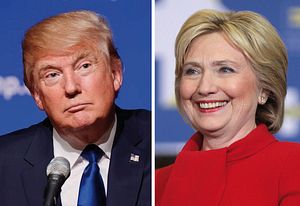The U.S. primaries are drawing to a close, Hillary Clinton and Donald Trump appear to have effectively clinched their party’s respective nominations. After a big win in Indiana on Tuesday, Trump’s only remaining rivals for the Republican nomination have withdrawn from the race. While Clinton’s challenger, Bernie Sanders, has vowed to fight on, the former secretary of state has built up an insurmountable delegate lead.
The two candidates could not be more different. As a commentary published by Gateway House put it, “Trump is the outsider, an invader in the Republican Party while Clinton is the ultimate insider, an integral part of the Democratic Party establishment.” Clinton is known to have the right personality to be an effective president; she is knowledgeable and experienced, though voters have doubts about her honesty. Trump is the brash newcomer who shows the energy and the ability to bring change to the country, and is perceived by many as being “honest and straightforward.”
With New Delhi’s growing stake in Washington, the White House’s next occupant is of special interest to Indian policymakers. Will the change in leadership affect U.S. policy towards India?
Since Trump announced his candidacy in 2015, his comments have often been branded as socially and politically incorrect, not only within the United States but in the world at large. Recently, Trump made waves by accusing Indians of taking American jobs. At a campaign rally, he poked fun of Indian call center representatives by apparently faking an Indian accent, though he immediately added that “India is a great place.” Previously, Trump had also spoken out against H-1B visas, many of which go to Indian workers. In 2015, 86 percent of all H-1B visas in the IT sector were issued to Indians.
In his quest to appear more presidential, Trump appears to have changed his tune and adopted a softer approach on immigration and employment issues. In March, he advocated allowing Indian students to stay in the country, saying, “They go to Harvard, they are first in their class and they’re from India, they go back to India and they set up companies and they make a fortune and they employ lots of people and all of that.” Clarifying his position on certain aspects of H-1B visas, he said, “Many people want to stay in this country… I think somebody that goes through years of college in this country, we shouldn’t kick them out the day they graduate, which we do.”
The announcement was naturally applauded by desis. There is even a Facebook page, Hindus for Trump, depicting the Republican front-runner sitting on a star-spangled lotus with a large “Om” written across it. Trump’s pro-business attitude finds resonance with the work ethic valued by many Indians in the United States. In addition, Trump may be receiving a boost from his party affiliation; Republicans are traditionally viewed as less anti-India than Democrats.
On the foreign policy front, Trump wants better relations with Russia and eschews interventions abroad, which should be welcome to New Delhi. Republicans are more worried about China and wish to bring India in as an ally. Trump’s suggestion that his administration could seek India’s cooperation to address the “real problem” of a nuclear-armed, “semi-unstable” Pakistan also resonated with Indians.
Clinton, for her part, has promised to take economic and strategic ties with India to a new level. There has been a significant presence of Indian-Americans supporting her campaign. Clinton’s ties with India have a long history. As first lady in the 1990s, she reportedly urged Bill Clinton to focus on India as an ally, a shift away from traditionally strained ties. In the first term of the Obama administration, Clinton, then secretary of state, was active in seeking more cooperation with India, including allying Indian and American intelligence to combat terrorism. She was also vocal regarding Pakistan’s harboring of terror groups. She was instrumental in the U.S. “pivot to Asia,” underlining the need to shift the U.S. foreign policy focus to South and Southeast Asia.
On the flip side, many in India see Clinton as responsible for initiating a “get Narendra Modi” policy, seeking to take down the then-chief minister for his alleged complicity in the 2002 Gujarat riots. Nonetheless by the time she left office, Clinton was seen as supportive toward the Modi government. When Modi visited the United States in 2014, he even visited the Clintons in New York.
It is a given that no matter who the president is, any policy change would be incremental at best. Foreign policy is not made by the president alone; the State Department, Congress and the Pentagon are all invested deeply in U.S. policymaking. Whether Republicans or Democrats, the U.S.-India relationship will be characterized by hard diplomacy and harder politics.
Economically, both Clinton and Trump have voiced their opinions regarding outsourcing and complained that America is importing more than exporting. This protectionist backlash has found its place in the election debates across both parties. However, there is a broad political consensus, a bipartisanship about maintaining a strategic relationship with India. India is an emerging economy and thus Washington will want to woo New Delhi, no matter who moves into the White House.
Shreya Upadhyay is a Research Scholar from the Jawaharlal Nehru University, New Delhi, India. She served as the Fulbright-Nehru doctoral fellow in the year 2015-2016.

































